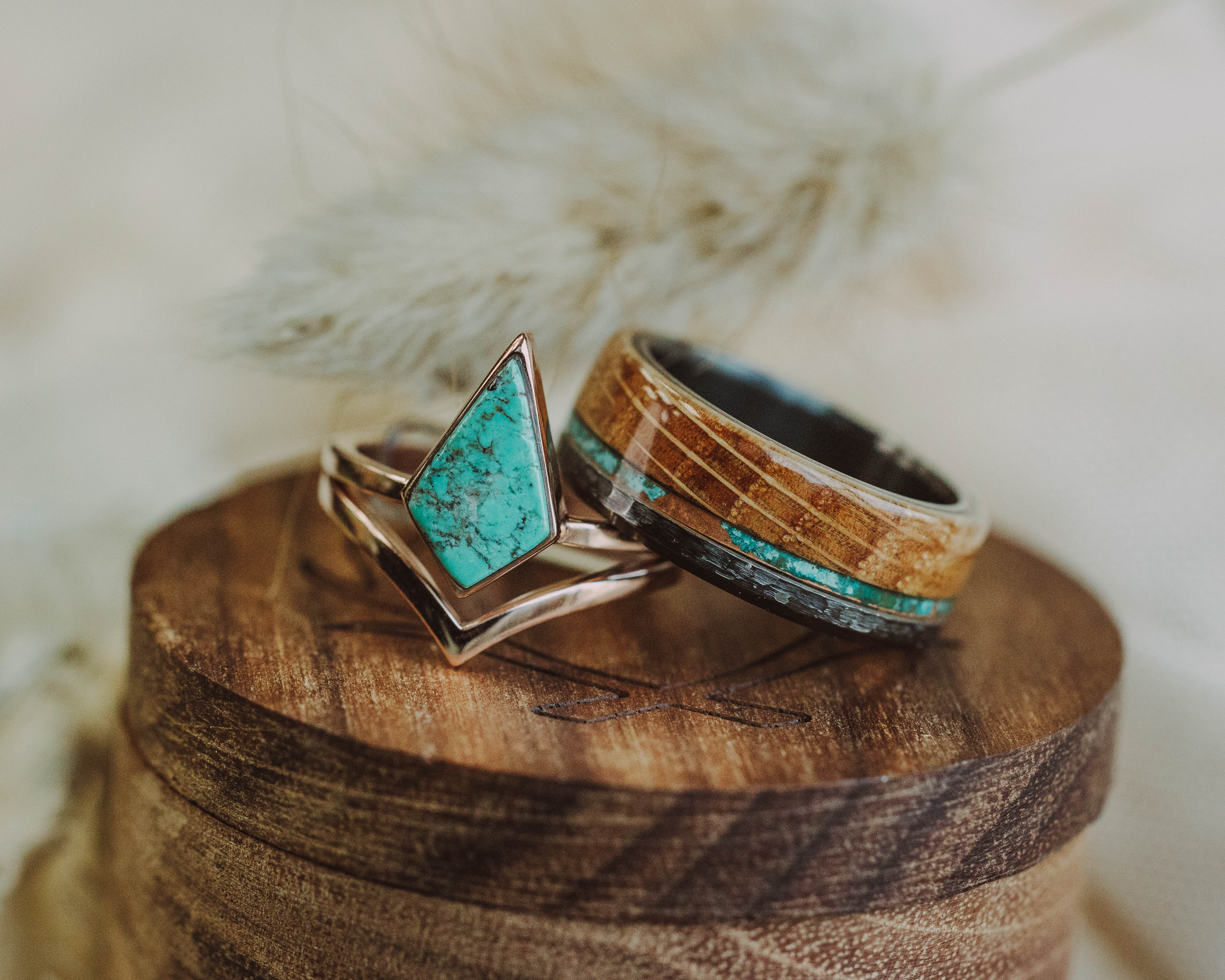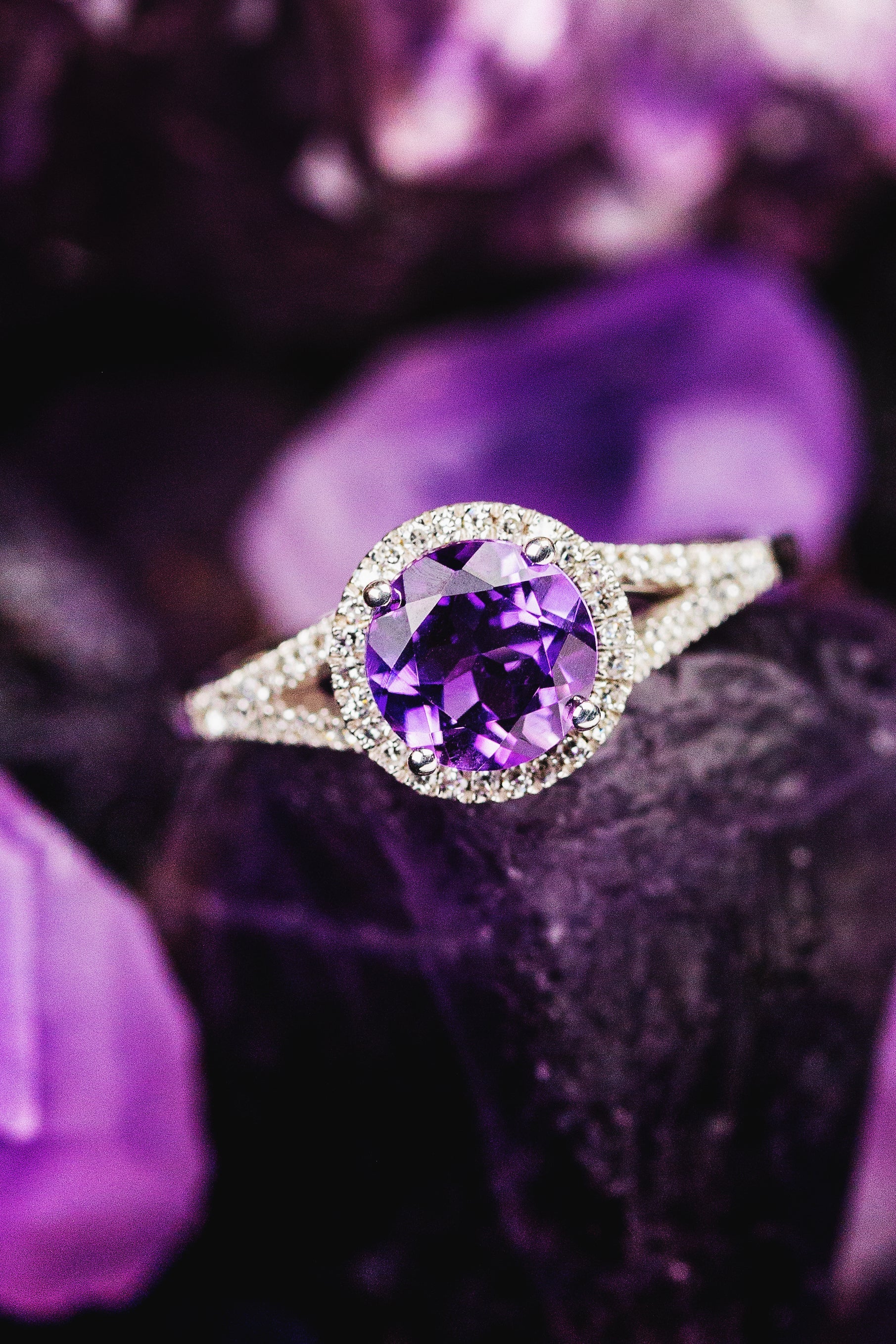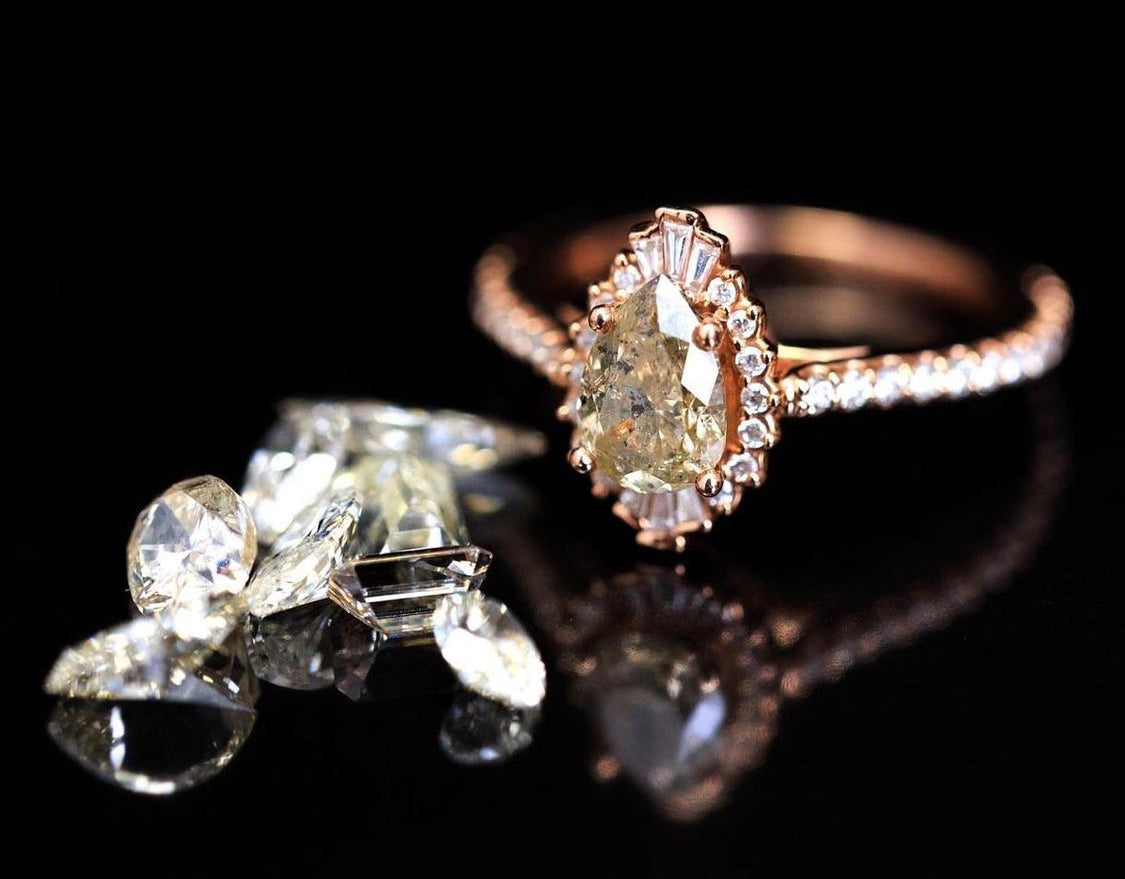
What is Turquoise? - Gem of the Earth, Sky, And Water
An ancient gemstone revered for thousands of years by cultures worldwide, Turquoise is a stunning stone found in mesmerizing colors that capture the essence of earth, water, and sky. For this reason, it is the featured material and a symbol for our Terrestrial Collection and many of our other standard & custom designs. This unique stone is found in several colors ranging from robin's egg blue to yellow-green, with distinctive veining or webbing called matrix. Turquoise is a gift from the earth and the perfect way to make any piece of jewelry meaningful and one-of-a-kind!
History & Origins
Turquoise is prevalent in many areas and cultures globally and dates back to the Ancient Egyptians, Ancient Persians, and Chinese artisans. It has been used in carvings and jewelry for thousands of years worldwide.
- Many cultures believed the stone provided protection and good fortune.
- Ancient Egyptians called the gem "Mefkat" which translates to "delight" and "joy" and often used it in ceremonies.
- The mask of King Tut has turquoise inlays.
- Also known as the "Persian blue" stone, the name "turquoise", eventually coined from the French words "pierre tourques" or "Turkish stone"; as Turkish traders bartered the stone in Europe in the 13th century through the Silk Road.
- In the now southwestern United States, Native American tribes used the stone as a form of currency, in ceremonies, and for creating jewelry and talismans.
- The Aztecs of Mesoamerica also used the stone for ceremonial purposes, mosaics, masks, and protection.
A Turquoise Scarab ring from ancient Egypt. Photo from The Metropolitan Museum of Art.
Stone Description
The color of Turquoise can range from pure sky-blue, green, and even yellow-green depending on the chemical and mineral makeup of the stone.
- The blue color of Turquoise comes from copper, so the more copper that is present, the more blue the stone will appear
- Pure sky-blue Turquoise is often called "Persian blue"
- Turquoise with more green or yellow typically has higher amounts of aluminum, iron, or zinc than blue Turquoise
The matrix, or veining, seen in Turquoise is from remnants of the host rock the Turquoise was mined from, often sandstone or limonite and other minerals such as quartz or pyrite. There are several different popular and common matrix patterns, such as spider-web and calico; however, some Turquoise may have minimal to no matrix. The matrix and variation in color seen in Turquoise are unique to each stone. They can even vary within a given piece, making it an excellent choice for creating a one-of-a-kind piece of jewelry!

Turquoise comes in a range of color between sky-blue and green and can have variation in the matrix. Photo from Tskies.
Variation In Your Turquoise - Choosing Your Stone:
- Because we use natural Turquoise in our rings, there will be variations in the color and the veining of the stone. This variation is not something we can control.
- Each stone is cut from a larger raw Turquoise piece and will vary considerably, even within the same raw Turquoise sample.
- Because we hand-cut and sand each stone for your specific ring mounting to create a perfect fit, we cannot provide the option of selecting an already cut stone for your ring.
- We also do not allow already cut Turquoise stones to be sent in because they may break during the setting process.
- If you would like to send a rough slab of Turquoise in to have cut into a center stone, you may do so at your own risk. Please understand that once we cut into it, there may be little or nothing left to return.
- It may still vary from the color and appearance shown on the outside of the stone you sent.
- It is also possible that we cut into your material but cannot cut a suitable piece for your ring, and your sample is left behind as waste.
- See the image below for a rough idea of how much material we might need to create a center stone.

Cut
Turquoise is typically cut into a cabochon or dome shape in a process called "cabbing." This cut is preferred because the opaqueness of Turquoise makes it a poor candidate for faceting. Instead, a cabochon cut helps showcase the color of the stone while minimizing the appearance of scratches. Turquoise can also be crushed and used in inlays and ring linings, which we offer on many of our turquoise ring designs!

This "Cleopatra" ring features a Turquoise cabochon cut center stone and crushed Turquoise inlays on the tracers.
Sourcing
Unfortunately, today Turquoise imitations being sold as "true Turquoise" have flooded the market and made it difficult to distinguish real from fake Turquoise. Imitation Turquoise is made from a variety of materials, including, but not limited to:
- Epoxy resin
- Dyed howlite
- Glass
- Plastic
Price is the most significant indicator in determining whether Turquoise is real or fake. Faux Turquoise is often sold at a low cost because it is inexpensive to produce and easy to create a convincing fake. Please buy from reputable sellers and companies who obtain Turquoise from reputable sources.
Lower quality Turquoise is often stabilized through treatment or dyed to achieve desired color and durability. Some low-quality Turquoise is also "backed" for extra stabilization to make the stone more durable. We do not work with backed Turquoise because of the quality and chance of the stone cracking and chipping during the setting process. In addition, the backing may cause the stone not to set correctly, and removal of the backing could cause the stone to fall apart.
Turquoise is found in dry climates where the groundwater is rich in copper, such as the Southwestern United States (especially Arizona and Nevada), Iran, Egypt, China, Tibet, Israel, Australia, and other areas with similar climates. The Turquoise we use in our rings and jewelry is ethically sourced from Southwestern United States mines, namely those in Nevada and Arizona, but we have sourced high-quality Turquoise from many mines across the world. Notable sources we've used are from China, the infamous BlueBird mine (known for its Turquoise with solid blue color and minimal matrix), the now-abandoned Mona Lisa mine of Arkansas, and the Gold Canyon Mine of Kingman, Arizona.
Modern Uses
Turquoise is still a popular stone, especially in the Southwestern United States. It is used for many purposes from spirituality and jewelry to carvings:
- Turquoise is one of the birthstones of December.
- Turquoise is the designated 11th wedding anniversary gemstone.
- Turquoise is frequently used in jewelry such as rings, necklaces, earrings, bracelets, pendants, etc., and is sometimes used as an inlay for belt buckles, boots, and other Western-inspired products.
- Turquoise is still of great importance to Native American tribes and cultures, especially the Navajo and Zuni, who believe the stone has special powers. These tribes create jewelry, beads, talismans, and other carvings from Turquoise.
- Turquoise is associated with the spirits and properties of water and the sky.
- Some people use Turquoise for chakra and spiritual/metaphysical healing.
- The Chinese still use Turquoise in carvings of intricate sculptures and beads.
Turquoise Care & Cleaning
Chemicals, solvents, heat, ultrasonic cleaners, and steam should not be used when cleaning Turquoise. For rings containing a turquoise center stone, wipe with a soft damp cloth using warm water & gentle soap to maintain the stone's integrity and appearance. The stone should be thoroughly dried after cleaning to prevent water damage. Clean Turquoise often to avoid damage and discoloration that could be caused by cosmetics, skin oils, and perfumes. Avoid contact with lotions, hand sanitizers, and other chemicals.
Because Turquoise ranks a 5-6 (medium hardness) on the Mohs hardness scale, take care not to chip or scratch your Turquoise. Store Turquoise pieces away from other jewelry that could cause scratching. Remove Turquoise or any other jewelry before:
- Going to the gym, doing manual labor, washing dishes, showering, etc.
- Participating in any other activity that could pose a risk to the ring and the safety of your fingers
Our crushed Turquoise rings and rings containing other material inlays are protected with a sealant that should make your ring more resistant against damage from water. However, this is only the case if the sealant is undamaged and remains intact around the entirety of your ring. It should also provide a more secure barrier for the natural materials in your band from impacts and scratching but still cannot be expected to be as durable as a solid metal ring. The sealant does not provide a guarantee or warranty against water damage or breakage due to impact or other forms of abuse. Rings containing crushed Turquoise inlays or inlays using any other material should be cleaned using only a microfiber cloth. If this method does not return the shine to your ring, please contact us for further assistance.
Click here to visit our Care Guidelines page for more information about ring care.
Creating Jewelry With Turquoise
If you want to create an engagement ring or a wedding set that is special to you and the one you love, Turquoise is a great way to go! Staghead Designs would be honored to help you create a meaningful piece! Click here to view our Terrestial Collection featuring turquoise designs or here for our original Turquoise Wedding Band Collection.



